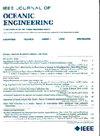Holistic Risk Modeling and Path Planning for Marine Robotics
IF 3.8
2区 工程技术
Q1 ENGINEERING, CIVIL
引用次数: 0
Abstract
Risk awareness and assessment are fundamental aspects of human cognition and situational awareness, and play crucial roles in problem solving and decision-making. In this article, we present a novel methodology for integrated risk modeling and path planning in robotics mimicking these human processes. This approach creates a holistic geospatial data structure of risk, showing what may go wrong, where and when it is more likely, and the potential causes and consequences; all of which may be used as input to planning and decision-making algorithms for improved robotic autonomy. First, a hazard analysis of the operation is performed, with the objective of analyzing possible hazardous events, their causal factors, and potential consequences. This knowledge is then incorporated into a Bayesian belief network for estimating the risk at a particular point in space and time. Two methods for path planning taking these results as input are proposed: first, the risk-based path planner, and second, the risk-based traveling salesperson, both of which can balance the tradeoffs between risk and reward related to the mission objectives. We demonstrate the novel methodology with a real case study: seabed survey of the Tautra coral reef in Norway using an autonomous underwater vehicle (AUV), capitalizing on data from previous field operations. The case study shows that the AUV adapts its mission based on the perceived and assessed risk. By combining methods from robotics, artificial intelligence, risk science, and geoinformatics this work provides an interdisciplinary and novel contribution to enhanced robotic autonomy.海洋机器人整体风险建模与路径规划
风险意识和评估是人类认知和态势感知的基本方面,在问题解决和决策中起着至关重要的作用。在本文中,我们提出了一种新的方法,用于模拟这些人类过程的机器人集成风险建模和路径规划。这种方法创建了一个整体的风险地理空间数据结构,显示出什么地方可能出错,何时何地更有可能出错,以及潜在的原因和后果;所有这些都可以作为规划和决策算法的输入,以提高机器人的自主性。首先,对手术进行危害分析,目的是分析可能发生的危险事件、其原因和潜在后果。然后将这些知识整合到贝叶斯信念网络中,用于估计空间和时间特定点的风险。以这些结果为输入,提出了两种路径规划方法:基于风险的路径规划者和基于风险的旅行销售人员,两者都可以平衡与任务目标相关的风险和回报之间的权衡。我们通过一个真实的案例研究展示了这种新方法:利用以前现场作业的数据,使用自主水下航行器(AUV)对挪威的Tautra珊瑚礁进行海底调查。实例研究表明,水下航行器根据感知和评估的风险来调整其任务。通过结合机器人技术、人工智能、风险科学和地理信息学的方法,这项工作为增强机器人自主性提供了跨学科和新颖的贡献。
本文章由计算机程序翻译,如有差异,请以英文原文为准。
求助全文
约1分钟内获得全文
求助全文
来源期刊

IEEE Journal of Oceanic Engineering
工程技术-工程:大洋
CiteScore
9.60
自引率
12.20%
发文量
86
审稿时长
12 months
期刊介绍:
The IEEE Journal of Oceanic Engineering (ISSN 0364-9059) is the online-only quarterly publication of the IEEE Oceanic Engineering Society (IEEE OES). The scope of the Journal is the field of interest of the IEEE OES, which encompasses all aspects of science, engineering, and technology that address research, development, and operations pertaining to all bodies of water. This includes the creation of new capabilities and technologies from concept design through prototypes, testing, and operational systems to sense, explore, understand, develop, use, and responsibly manage natural resources.
 求助内容:
求助内容: 应助结果提醒方式:
应助结果提醒方式:


